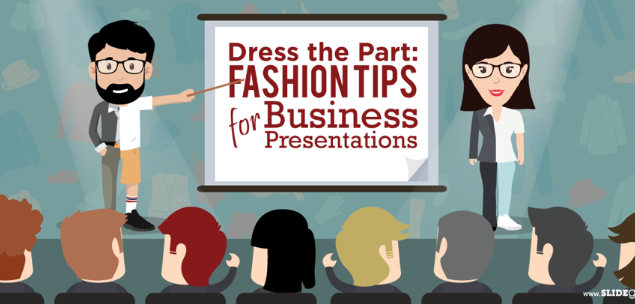Let’s not be cliché and use the line, “clothes make the man.” Choosing what to wear in a presentation wasn’t always this hard. Previously, a suit and tie were enough – coat optional. But with so many styles and preferences nowadays, striking the perfect balance to please an audience is proving to be more and more impossible.
So what makes the perfect outfit for a presentation? It’s impossible to say. But don’t let this stop you from charming your audiences and capturing their attention.
Consider your audience’s look and profession
Does your audience fall in the conservative (‘suit and tie’) or casual (‘wear whatever you want’) camp or somewhere in between?
It’s common advice to dress like your audience – if not exactly at their level, then a slight notch above. Emphasis on the “slight.” Don’t overdress: you wouldn’t want to stand out for the wrong reasons or worse, become a distraction. That will mean your efforts are wasted.
Remember: you are being judged initially because of what you wear. Make that initial judgment a good one.
Match the situation
Gauge the general atmosphere and get a sense of the surroundings of your stage. Are you going to speak from a wide, raised platform? Then you’re sure to be seen. Will your venue be a small function room? Then you’ll have a smaller stage. What are the initial distractions that can be eliminated, done away with or worked around?
An assessment of the venue, including the inherent distractions, will help you prepare both mentally and physically—specifically, your clothes. Like how soldiers wear camo, your outfit should not only reflect how prepared you are but also protect you from the elements that can distract you and your audience.
Prioritise comfort
Everyone has had the feeling of sweating in their clothes, maybe because of exercise or the current weather situation. It’s always the same feeling: uncomfortable, sticky, and annoyingly wet.
You wouldn’t want that when presenting in front of a crowd of colleagues and even superiors. The last thing they need as a distraction is anything that will make them feel like something is out of place.
You will be under the spotlight quite literally, and that beam is going to be hot. You will also be moving around the stage in an effort to ‘own’ the presentation space for maximum showmanship points. It would be best to feel comfortable moving around and not have that sweat coming back to you.
Avoid bright colours and distracting prints
Let’s talk colours. You may have a favourite shirt or blouse you want to wear all the time, but when it comes to public speaking, ask yourself: ‘will my awesome shirt be a distraction?’ If it’s so awesome that your audience doesn’t—or can’t—focus on you, then no, don’t wear it.
The general rule is to avoid colours that will make them cringe. A neon green top, for instance, stands out even without being illuminated by a bright light and is painful on the eye. Instead, choose colours that look refreshing, like sky blue, earth yellow, or rose quartz.
Company colours are also a good choice, especially when colour psychology is in play. Which hue, shade, or tint will make you seem friendly?
Stay away from vulgar and possibly offensive “statement shirts.” You might think you’re being humorous, sure, but humour is is as subjective as beauty. Try a plain colour that you can deck out with accessories. That way, there’s no print, and all eyes are on you.
Focus on the finer details
When you’ve got your outfit worked out, it’s time to accessorise and iron out any wrinkles on your general look.
For women, makeup is not taboo. Strike a balance that’s neither too powerful nor too thick (imagine the smears when you sweat.) A professional look involving neutral colours is the best choice. You wouldn’t want your audience focused solely on your face. A piece or two of jewelry is fine as well, as long as they enhance your look and don’t scream for attention.
Men need not fear facial hair, especially when it works for them. (Let’s face it: Some men rock the bearded look). Just make sure you are well-groomed. A fancy wristwatch is fine, too, as long it doesn’t reflect light into someone’s eyes.
Of course, it’s also best to make sure that you’ve literally ironed out the wrinkles of your clothes. Look shabby and unprofessional in front of your audience and they won’t take you seriously.
Clothes are a basic necessity, but when you’re doing something that’s not elementary, it’s not just your game you have to step up. Have the threads to boot.
If dressing well boosts your self-esteem, then do so. In a room where you’re the focus of attention, a powerful statement of “Look at me!” may put the pressure on you, but you’ll go some way to acing it if you’re confident. Appropriately dressed presenters are individuals that audiences can’t help but take seriously. Make your voice—and message—be heard.
About the author
Rick Enrico is the CEO and Founder of SlideGenius, Inc. He regularly publishes expert presentation tips on the SlideGenius blog. You can connect with him on LinkedIn and Twitter.
Resources
Ciotti, Gregory. “The Psychology of Color in Marketing and Branding.” Entrepreneur. April 13, 2016. www.entrepreneur.com/article/233843
Dlugan, Andrew. “How to Dress for Public Speaking.” Six Minutes. December 5, 2011. sixminutes.dlugan.com/dress-public-speaking
Morgan, Nick. “How To Avoid Disaster – Six Rules For What To Wear When Giving A Speech.” Forbes. December 5, 2013. www.forbes.com/sites/nickmorgan/2013/12/05/how-to-avoid-disaster-six-rules-for-what-to-wear-when-giving-a-speech/#231f4f3f2dce
Nagel, Audrey. “To Wear or Not to Wear: Dressing for Presentations.” Designed to Learn. May 6, 2015. lpd.nau.edu/to-wear-or-not-to-wear-dressing-for-presentations
Saint Laurent, Yves. “What To Wear: On Speaking Engagements – 8 Tips To Show That You Mean Business.” Corporate Fashionista. March 23, 2010. www.corporatefashionista.com/what-to-wear-on-speaking-engagements

